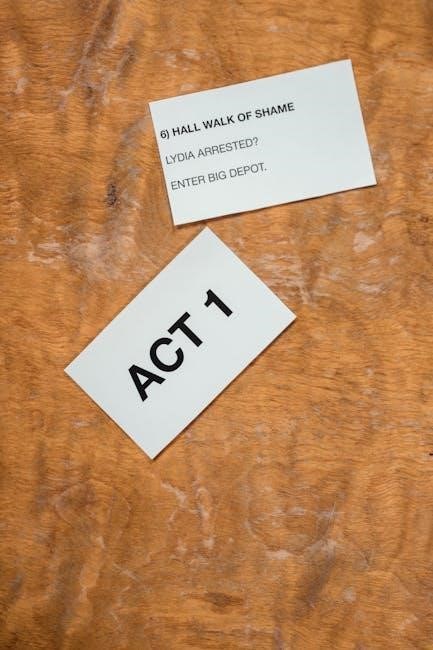Chapter 2 of The Great Gatsby introduces the Valley of Ashes, a desolate region between Long Island and New York, symbolizing moral decay and social stratification. It explores Tom’s double life, his affair with Myrtle Wilson, and the stark contrasts between wealth and poverty, setting the stage for themes of deception and class divisions that drive the novel’s narrative.
Overview of the Chapter’s Significance
Chapter 2 of The Great Gatsby is pivotal as it introduces key themes of moral decay, social stratification, and deception. The Valley of Ashes, a desolate landscape, symbolizes the corruption beneath the glittering surface of wealth. Tom’s affair with Myrtle Wilson exposes his hypocrisy and the rigid class divisions of the 1920s. This chapter deepens the narrative by revealing the darker truths of the characters’ lives, setting the stage for the tragic events that unfold, and highlighting the illusion of social mobility in a divided society.
Key Themes Introduced in Chapter 2
Chapter 2 introduces themes of moral decay, social stratification, and hypocrisy. The Valley of Ashes symbolizes the corruption beneath the wealthy elite’s glamorous facade. Tom’s affair with Myrtle highlights class divisions and the exploitation of power. The chapter also explores deception and betrayal, as Tom’s double life and Myrtle’s aspirations reveal the tension between reality and illusion. These themes underscore the societal divide and the corrupting influence of wealth, setting the tone for the novel’s exploration of the American Dream’s illusion.
The Valley of Ashes
The Valley of Ashes is a desolate region between Long Island and New York, characterized by gray wasteland and industrial decay, symbolizing moral corruption and societal neglect.
Description of the Setting
The Valley of Ashes is a desolate, gray wasteland between Long Island and New York City, where industrial ashes and smoke dominate the landscape. It is home to the working class and the morally corrupt, contrasting sharply with the wealth of the Eggs. The giant eyes of Doctor T.J. Eckleburg loom over the valley, symbolizing divine judgment. The setting emphasizes the stark divide between opulence and poverty, creating a bleak backdrop for the unfolding events of the chapter.
Symbolism of the Valley of Ashes
The Valley of Ashes symbolizes moral decay, social corruption, and the stark contrast between wealth and poverty. It serves as a visual representation of the moral emptiness of the wealthy elite, while the giant eyes of Doctor T.J. Eckleburg signify divine judgment over the characters’ actions. The desolate landscape contrasts sharply with the opulence of East and West Egg, underscoring the deep-seated class divisions and the illusion of a perfect society in 1920s America.
Its Role in Highlighting Social Disparities
The Valley of Ashes starkly highlights the deep social and economic divides of the 1920s. Its desolate landscape and struggling inhabitants contrast sharply with the opulence of East Egg and West Egg, symbolizing the exploitation and neglect of the working class. The Valley serves as a moral backdrop, exposing the hypocrisy of the wealthy elite like Tom Buchanan, who exploit those in the Valley for their own desires, while maintaining a facade of superiority and refinement in their own communities.

Tom Buchanan’s Character Development
Chapter 2 reveals Tom’s aristocratic entitlement and double life, exposing his hypocrisy and abusive nature through his treatment of Myrtle and George Wilson, highlighting his moral decay.
Chapter 2 exposes Tom Buchanan’s dual existence, contrasting his polished public persona with his secretive, manipulative private life. His affair with Myrtle Wilson, set against the bleak backdrop of the Valley of Ashes, reveals his exploitation of privilege and disregard for morality. Through his controlling behavior and hypocritical actions, Fitzgerald portrays Tom as a symbol of corrupt wealth, whose double life underscores the moral decay of the elite in the 1920s.
Tom’s Relationship with Myrtle Wilson
Tom’s relationship with Myrtle Wilson is marked by exploitation and emotional detachment. Myrtle, trapped in a working-class marriage with George, sees Tom as an escape to luxury and status. However, Tom treats her as a disposable conquest, slapped her when she mentions Daisy, revealing his controlling and abusive nature. Their dynamic highlights the power imbalance in their social classes and the superficiality of their connection, which lacks genuine affection or commitment. This affair underscores Tom’s hypocrisy and moral corruption.
Analysis of Tom’s Hypocrisy
Tom Buchanan’s hypocrisy is evident in his self-righteous facade and immoral actions. While he condemns others for their transgressions, he justifies his own infidelity with Myrtle Wilson. His willingness to criticize Daisy for her feelings for Gatsby, while openly maintaining his affair, showcases his double standards. The physical and emotional abuse of Myrtle further highlights his controlling and manipulative nature. This hypocrisy underscores his corrupt character, emphasizing the moral decay and societal privilege that enable his actions without accountability.

Myrtle Wilson’s Character Analysis
Myrtle Wilson, trapped between poverty and aspiration, embodies the tragic consequences of chasing an unattainable dream. Her desire for luxury and status drives her actions, yet her circumstances lead to inevitable downfall, highlighting the rigid social stratification of the 1920s.
Background and Social Status
Myrtle Wilson resides in the Valley of Ashes, a desolate area symbolizing moral decay. She belongs to the working class, married to George Wilson, who struggles to maintain his failing gas station. Myrtle’s background is marked by poverty and limited opportunities, fueling her resentment and desire for a better life. Her social status is far below that of the wealthy elite, like the Buchanans, making her an outsider in their world. This disparity drives her longing for luxury and escape from her dismal reality.
Her Motivations and Desires
Myrtle Wilson is driven by a deep longing to escape her impoverished life in the Valley of Ashes. She aspires to join the wealthy elite, envying Daisy Buchanan’s luxurious lifestyle. Her desire for social upward mobility and material comfort leads her to pursue Tom Buchanan, seeing him as a means to achieve her dreams. Myrtle’s resentment toward her circumstances fuels her reckless pursuit of luxury and status, even if it means compromising her marriage and dignity.
Her Role in the Chapter’s Conflict
Myrtle Wilson’s actions in Chapter 2 ignite tension by exposing Tom’s infidelity, creating a rift in his marriage and fueling George Wilson’s despair. Her pursuit of luxury and rebellion against her circumstances escalates the conflict, bridging the gap between Tom’s double life and the moral decay of the Valley of Ashes. Myrtle’s desperation to escape her reality not only deepens the chapter’s emotional turmoil but also foreshadows the tragic consequences of her pursuit of wealth and status through illicit means.

Nick Carraway’s Perspective
Nick acts as an observer and moral compass, witnessing Tom’s affair with Myrtle and the decay of the Valley of Ashes, while grappling with the moral ambiguity surrounding him.
Nick’s Observations of Tom and Myrtle
Nick witnesses Tom’s infidelity firsthand, observing the tension and superficiality of their relationship. He notes Tom’s duplicity and Myrtle’s desperation to escape her circumstances. Nick’s moral discomfort grows as he sees the exploitation and hypocrisy in their interactions, highlighting the corrupting influence of wealth and power. His observations underscore the decay of moral values in the Jazz Age, while also revealing his own conflicted feelings about the decadence surrounding him.
Nick’s Moral Stance on the Affair
Nick, with his Midwestern moral grounding, is deeply unsettled by Tom’s infidelity and the superficiality of the affair. He disapproves of the exploitation and hypocrisy, yet remains detached, observing without interfering; His passivity reflects his conflicted sense of duty and the moral ambiguity of the East Coast elite. Nick’s discomfort highlights the ethical decay of the Jazz Age, while his inaction underscores his own complicated relationship with judgment and non-judgment in a corrupt world.
Nick’s Role as a Narrator in the Chapter
Nick Carraway serves as both a participant and an observer in Chapter 2, offering a unique perspective on the events. His Midwestern values make him a reliable yet detached narrator, allowing readers to witness the moral decay of the wealthy elite. Through his descriptions, Nick subtly critiques the hypocrisy and superficiality of Tom and Myrtle’s affair, while his own involvement in the story blurs the line between observer and participant. His narrative voice provides clarity and insight into the chaotic world he describes.

The Party in Manhattan
The party in Manhattan, hosted in Tom’s secret apartment, showcases the superficiality of the wealthy elite. It highlights Tom’s infidelity and the moral decay of the Jazz Age, revealing the shallow lives of the characters involved.
Description of the Party Scene
In Tom’s Manhattan apartment, the party unfolds as a chaotic, intimate gathering. Myrtle, George Wilson, and others mingle in a cramped, vulgar setting. Alcohol flows freely, creating a tense, charged atmosphere. Myrtle’s loud, pretentious behavior contrasts with Tom’s cool detachment. The scene is marked by underlying conflicts, drunkenness, and a sense of moral decay, highlighting the superficiality of the wealthy elite and their reckless indulgence.
The Atmosphere and Tensions
The party in Tom’s apartment is charged with underlying tension and moral decay. Myrtle’s pretentiousness and Tom’s detached cruelty create an air of unease. Drunkenness amplifies the characters’ true selves, revealing deep-seated insecurities and social pretensions. The cramped, vulgar setting exacerbates the emotional volatility, leading to confrontations. Nick’s observational detachment contrasts with the chaos, highlighting the superficiality and hypocrisy of the wealthy elite, setting the stage for future conflicts.
Significance of the Party in the Chapter
The party in Manhattan serves as a catalyst for revealing the moral decay and superficiality of the wealthy elite. It exposes Tom’s infidelity, Myrtle’s desperation, and the societal divide. The chaotic, drunken atmosphere underscores the emptiness of their lives, while Nick’s observant perspective highlights the hypocrisy. This scene symbolizes the corruption of the Jazz Age, showcasing how wealth and privilege mask deepest insecurities, ultimately foreshadowing the doomed pursuit of the American Dream and the inevitable collapse of illusion.

George Wilson’s Role
George Wilson embodies the struggles of the working class, overwhelmed by his circumstances. His helplessness and despair reflect the harsh realities of poverty and exploitation, emphasizing the deep social divides of the 1920s.
George Wilson is the proprietor of a crumbling gas station in the Valley of Ashes, a stark contrast to the opulence of the wealthy communities nearby. He is a working-class man trapped in a life of poverty and despair, struggling to maintain his business and marriage. His worn appearance and defeated demeanor reflect the toll of his hardships. Wilson’s character represents the forgotten individuals in society, highlighting the deep social and economic divides of the 1920s.
His Awareness of Myrtle’s Affair
George Wilson is painfully aware of his wife Myrtle’s infidelity with Tom Buchanan. Despite his knowledge, he feels powerless to stop it, overwhelmed by his own financial struggles and social inferiority. His helplessness is evident in his downtrodden demeanor and inability to confront the reality of their crumbling marriage. This awareness deepens his despair, highlighting the tragic consequences of his circumstances and the societal divides that trap him in a cycle of desperation and defeat.
His Helplessness and Desperation
George Wilson’s awareness of Myrtle’s affair with Tom Buchanan fills him with a profound sense of helplessness and desperation. He is trapped by his financial struggles, unable to escape the Valley of Ashes or provide a better life for Myrtle. His powerlessness is magnified by his social status, leaving him unable to confront Tom or save his marriage. This desperation fuels his frustration and hopelessness, symbolizing the entrapment of the working class in a society dominated by wealth and privilege.

Social Class and Stratification
Chapter 2 highlights the stark divide between old money and the working class, emphasizing the rigid social hierarchy of the 1920s through settings like the Valley of Ashes.
Contrast Between Old Money and New Rich
In Chapter 2, the contrast between old money and new rich is vividly portrayed through characters like Tom Buchanan and Jay Gatsby. Old money, represented by Tom, signifies inherited wealth and social prestige, while the new rich, like Gatsby, embody self-made wealth but lack the same societal acceptance. This divide is highlighted by their lifestyles and neighborhoods—East Egg for old money and West Egg for the new rich. Fitzgerald uses this contrast to critique the rigid social stratification and the snobbery of the elite, emphasizing the illusion of upward mobility in the 1920s. The tension between these groups underscores the novel’s exploration of class and identity.
The Divide Between the Wealthy and the Working Class
Chapter 2 vividly portrays the stark divide between the wealthy elite and the working class through the setting of the Valley of Ashes. This desolate, industrial wasteland, home to characters like George and Myrtle Wilson, contrasts sharply with the opulent communities of East Egg and West Egg. The wealthy, such as Tom and Daisy, exploit the working class for their own pleasure, while the latter remain trapped in poverty. Myrtle’s desire to escape her circumstances through her affair with Tom highlights the economic and social chasm, emphasizing the impossibility of bridging this gap in a rigidly stratified society.
The Illusion of Social Mobility
The Valley of Ashes in Chapter 2 underscores the illusion of social mobility in 1920s America. Myrtle Wilson, trapped in poverty, aspires to join the elite through her affair with Tom, but her efforts are futile. George Wilson, her husband, is equally ensnared, unable to escape his despair. Fitzgerald critiques the American Dream by showing how rigid class structures prevent true upward mobility, highlighting the divide between old money and the working class. This illusion of opportunity reinforces the novel’s themes of inequality and disillusionment.

Symbolic Elements in Chapter 2
The Valley of Ashes symbolizes moral decay, while the giant eyes of Doctor T.J. Eckleburg represent divine judgment. The gray, ash-covered landscape mirrors the characters’ emotional barrenness, and the oppressive weather reflects underlying tensions, enhancing the chapter’s somber tone and foreshadowing tragic events.
The Eyes of Doctor T.J. Eckleburg
The giant, faded eyes of Doctor T.J. Eckleburg loom over the Valley of Ashes, serving as a haunting symbol of moral judgment and divine oversight. Positioned on a crumbling billboard, they appear to watch over the characters’ actions, emphasizing themes of guilt and accountability. These eyes are often interpreted as a representation of God or a higher power, observing the moral decay and hypocrisy prevalent in the society depicted. Their presence underscores the idea that judgment is inescapable, even in a corrupt world.
The Color Imagery in the Valley of Ashes
The Valley of Ashes is dominated by a bleak, gray landscape, symbolizing moral decay and desolation. The dull, lifeless hues contrast sharply with the vibrant colors of wealthy communities, emphasizing the stark social divide. The ashes themselves, scattered and barren, reflect the remnants of indulgence and corruption. This color imagery reinforces the idea of a morally empty and decaying society, where beauty and ugliness coexist in stark relief.
The Use of Weather as a Symbol
In Chapter 2, Fitzgerald employs weather to symbolize tension and moral decay. The oppressive heat and dusty atmosphere of the Valley of Ashes mirror the moral desolation of its inhabitants. The sweltering conditions heighten the sense of discomfort and foreboding, reflecting the characters’ emotional states. This weather imagery also underscores the corruption and decay hidden beneath the surface of wealthy communities, foreshadowing the turmoil and tragic events that will unfold in the story.

Themes of Deception and Betrayal
Chapter 2 explores deception through Tom’s double life and affair with Myrtle, while Myrtle’s own deceitful aspirations amplify the betrayal, reflecting the moral corruption of the Valley of Ashes.
Deception in Tom’s Relationships
Tom’s deception is evident in his double life, as he maintains a polished facade with Daisy while engaging in a secret affair with Myrtle. His hypocrisy shines through when he criticizes others for infidelity, yet he is unfaithful himself. Tom manipulates those around him, including Myrtle, by pretending to care for her while treating her as a mere convenience. This duplicity highlights his moral corruption and the emptiness of his privileged existence, contrasting sharply with the genuine emotions of those he exploits.
Betrayal of Trust in the Chapter
Tom’s infidelity with Myrtle betrays Daisy’s trust, revealing the cracks in their marriage. Myrtle, desperate for escape, betrays George by pursuing Tom, despite his cruelty. George, unaware of Myrtle’s affair, feels betrayed by her growing detachment. Nick, witnessing these deceptions, is disheartened by the moral decay. The chapter underscores how betrayal corrupts relationships, leaving emotional scars and reinforcing the emptiness of the wealthy elite’s superficial lives, where trust is repeatedly broken for fleeting desires.
The Consequences of Deception
The consequences of deception in Chapter 2 are profound, leading to emotional turmoil and fractured trust. Tom’s hypocrisy and Myrtle’s affair create a web of lies that erode relationships, while George’s helplessness intensifies his despair. The moral decay evident in their actions underscores the destructive power of deception, which not only harms individuals but also perpetuates the corrupt societal norms of the wealthy elite, leaving scars that resonate throughout the novel.

Foreshadowing in Chapter 2
Foreshadowing in Chapter 2
Chapter 2 foreshadows the tragic events through the Valley of Ashes, symbolizing moral decay, and the ominous eyes of Doctor T.J. Eckleburg, hinting at impending judgment and consequences.
Hints at the Tragic Ending
Chapter 2 subtly foreshadows the tragic events that unfold later in the novel. The Valley of Ashes, with its desolate landscape and moral decay, symbolizes the inevitable consequences of the characters’ actions. The tension between Tom and Myrtle, particularly his violent outburst, hints at the explosive conflicts to come. Additionally, Myrtle’s desperate pursuit of a better life and her trapped circumstances suggest a doomed fate, aligning with the broader themes of illusion and destruction that define the novel’s tragic trajectory.
Clues About Gatsby’s Past
Chapter 2 offers subtle hints about Gatsby’s mysterious past, such as the source of his wealth and his connection to organized crime. Nick’s observations of Gatsby’s grand parties and lavish lifestyle suggest a man determined to escape his humble beginnings. Additionally, Gatsby’s proximity to Daisy’s home in West Egg implies a deeper, unresolved connection, hinting at a romantic history that drives his motivations. These clues begin to unravel the enigma of Gatsby’s identity and ambitions, central to the novel’s unfolding drama.
Forewarning of Daisy’s Involvement
Chapter 2 subtly foreshadows Daisy’s eventual involvement in Gatsby’s life through her absence and the tension surrounding her marriage to Tom. Nick’s interactions with Daisy and Tom hint at underlying unhappiness in their relationship, suggesting vulnerability. The chapter’s focus on Tom’s infidelity and the social divide between old money and new rich indirectly highlights Daisy’s potential role in Gatsby’s pursuit of wealth and status, preparing the reader for her reemergence as a central figure in Gatsby’s aspirations.
Chapter 2 ends with a heightened awareness of the moral decay and social tensions, as George Wilson’s suspicion of Myrtle’s affair grows, foreshadowing future conflicts.
Chapter 2 introduces the Valley of Ashes, a desolate area between Long Island and New York, symbolizing moral decay. Tom Buchanan’s affair with Myrtle Wilson is revealed, showcasing his hypocrisy and double life. Myrtle’s working-class background and desire for wealth are highlighted. The chapter also introduces George Wilson, Myrtle’s husband, who is aware of her infidelity and feels powerless. Nick Carraway witnesses the affair and the tension it creates, while the party in Manhattan amplifies the moral corruption and social divide, setting the stage for future conflicts.
Impact on the Overall Plot
Chapter 2 significantly advances the plot by revealing Tom’s infidelity and the moral decay of the wealthy elite. The introduction of Myrtle Wilson and the Valley of Ashes highlights the stark social divide, while the party in Manhattan escalates tensions and showcases the reckless excess of the Jazz Age. These events underscore the corrupting influence of wealth and set the stage for the tragic consequences of Gatsby’s pursuit of Daisy, emphasizing the illusion of social mobility and the inevitable clash of old money and new riches.
Setting the Stage for Future Chapters
Chapter 2 lays the groundwork for future conflicts by introducing key characters and their motivations. The revelation of Tom’s affair with Myrtle and the tensions in the Valley of Ashes foreshadow the inevitable clash between old money and new wealth. The party in Manhattan highlights the reckless excess of the Jazz Age, while George Wilson’s awareness of Myrtle’s infidelity plants seeds of revenge. These elements collectively create a tense atmosphere, propelling the narrative toward the tragic events that will unfold in subsequent chapters.
